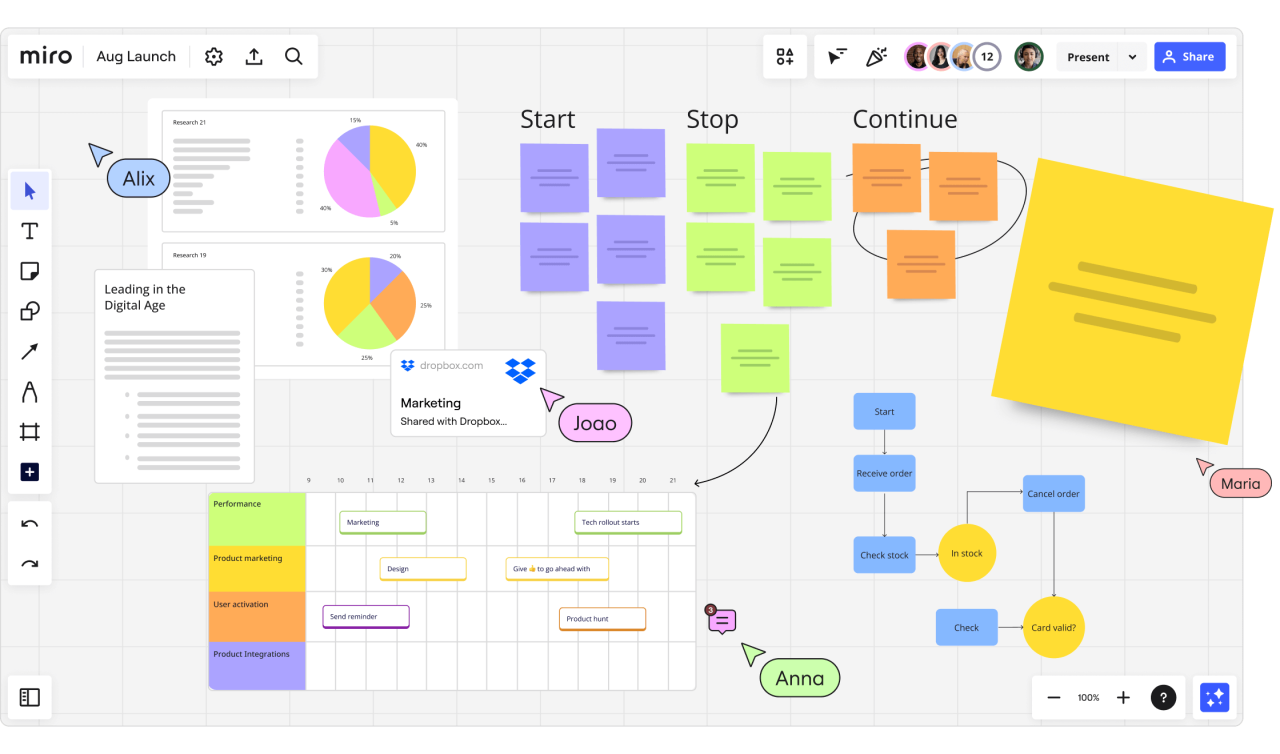Insight Blog
Agility’s perspectives on transforming the employee's experience throughout remote transformation using connected enterprise tools.
11 minutes reading time
(2232 words)
Effective Collaboration Strategies for Remote Creative Teams
Discover effective strategies to enhance collaboration in remote creative teams, including tools, communication tips, and activities to boost productivity and cohesion.
Remote work has revolutionized project management, enabling global connections and creativity without sacrificing quality.
The digital environment supports collaboration that feels as natural as working side-by-side.
Utilizing streamlined communication tools and shared digital workspaces, teams benefit in numerous ways. They enjoy flexibility, access to a diverse talent pool, and enhanced productivity, all without being limited by geography.
This shift is more than just convenient; it's transformative for creative projects requiring close coordination and innovative ideas. Grab a coffee as we delve into how teams can effectively collaborate on remote creative projects.
Today, effective collaboration among remote teams is not just a luxury but a necessity. Imagine being part of a global team spread across various countries and time zones, working towards a common goal without ever meeting in person. It sounds challenging, and it can be, but with the right strategies and tools, remote collaboration can lead to unprecedented levels of productivity, creativity, and success.
This experience underscored the importance of effective communication and teamwork, even without physical interaction. Was it tough? Absolutely! But through these challenges, we demonstrated our resilience, adaptability, and ability to move forward together. In this article, we're going to delve deeper and explain how Remote Teams Can Collaborate on Creative Projects.
Managing Remote Creative Teams Effectively
Navigating remote creative teams requires a distinct strategy, emphasizing task assignment and cultivating a collaborative and innovative culture. Regular check-ins are crucial for maintaining alignment and preventing team members from feeling isolated.
Utilizing collaborative tools is essential in this process. Platforms like AgilityPortal and Microsoft Teams facilitate instant communication, while project management software such as Trello or Asana ensures seamless progress tracking. According to a 2020 study by Buffer, 20% of remote workers identified collaboration and communication as their biggest struggles, highlighting the importance of these tools.Encouraging open dialogue is another crucial aspect. Promoting idea-sharing and problem-solving allows every team member to contribute their expertise, leading to more prosperous and more diverse project outcomes. A report from the Harvard Business Review found that companies fostering open communication were 25% more likely to have highly engaged employees, which translates to more effective and innovative teamwork.
Remote work presents challenges such as maintaining team cohesion and ensuring clear communication. Statistics from a 2021 Gartner survey reveal that 70% of remote workers feel more isolated, and 62% experience increased stress levels. These challenges underline the necessity of a thoughtful approach to managing remote teams.
- Establish Regular Check-Ins: Schedule frequent virtual meetings to discuss progress, address concerns, and keep everyone aligned. This helps prevent isolation and ensures that everyone is on the same page.
- Utilize Collaborative Tools: Implement platforms like Slack and Microsoft Teams for communication and use project management tools like Trello, Asana or Businessmap to streamline workflow, assign tasks, and monitor progress.
- Promote Open Communication: Encourage team members to openly share their ideas and feedback. Create an environment where everyone feels comfortable contributing their insights and expertise.
- Ensure Clarity with Clear Goals and Expectations: Define precise objectives, deadlines, and responsibilities for each team member. This ensures everyone knows their role and what is expected of them, fostering focus and productivity.
- Foster Team Engagement and Well-Being: Organize virtual team-building activities and provide support resources to address feelings of isolation and stress. Encourage a healthy work-life balance to keep team morale high and maintain engagement.
By fostering a culture of collaboration, leveraging the right tools, and encouraging open communication, teams can overcome these challenges and achieve successful, innovative project outcomes.
Leveraging Intranet Platforms for Seamless Collaboration
Intranet platforms serve as the backbone for remote team collaboration. They provide a centralized hub where information, resources, and communication come together seamlessly. This ensures that everyone stays in the loop.
These platforms excel at fostering real-time collaboration, breaking down silos between departments or individuals.
Examples include:- AgilityPortal: Offers document management and storage system capabilities, allowing teams to share and collaborate on files effortlessly.
- Confluence by Atlassian: Acts as a collaborative workspace where teams can create, organize, and discuss work in one place.
With these tools at your disposal, you empower your team to work more cohesively and productively from any location.
Software Solutions for File Sharing and Task Management
File sharing and task management are pivotal in remote collaborations. The right software can make these processes smooth, efficient, and stress-free. It's about finding tools that fit your team's specific needs.
Here are some top choices:
- AgilityPortal: Cloud Intranet Software Helps You Communicate, Collaborating, and Stay Connected by providing users with a document library, project management, task list, and many more features.
- Google Drive: Offers ample cloud storage where multiple users can store, access, and edit files simultaneously. Its real-time collaboration features ensure everyone works on the most up-to-date documents.
- Dropbox Business: Provides a secure space for file sharing with advanced administrative controls. Teams can easily manage permissions and keep sensitive data protected.
- Asana: A comprehensive project management tool where you can assign tasks, set deadlines, and track progress effortlessly. Visual timelines help in planning projects from start to finish.
- Trello: Uses boards, lists, and cards to organize tasks visually.
- Creative Work Distribution Platforms: A great option for managing creative outputs is DistroVid. It supports musicians by getting their videos onto platforms like Apple Music, TikTok, Vevo, Boomplay, and Tidal, generating earnings after finalizing video content through seamless teamwork. You just need to upload clips to DistroVid directly after wrapping up your collaborative efforts.
Choosing the right combination of these tools tailors your workflow to be as productive as possible while ensuring that every team member stays engaged throughout the project lifecycle.
Follow us and access great exclusive content everyday: Follow us on Google News
Enhancing Communication in Remote Teams
Effective communication is the linchpin of any remote team's success. It bridges gaps, ensuring everyone stays on the same page. Tools like Zoom and Slack facilitate real-time discussions, making collaboration seamless.
Regular video meetings create a sense of connection, fostering camaraderie among team members. This human touch is vital; its impact in making employees feel included cannot be overlooked.
Incorporating various channels for updates and feedback ensures that ideas flow freely. This multi-faceted approach nurtures an environment where creativity thrives, keeping projects moving forward smoothly.
Using Collaborative Design Tools like Figma and Miro
Collaborative design tools like Figma and Miro have revolutionized how creative teams work together. They provide a shared space where team members can contribute in real time, fostering an environment of seamless cooperation.
Figma allows designers to work on the same project simultaneously, streamlining feedback loops and reducing turnaround times. It keeps everyone visually aligned with interactive prototypes.
Miro's digital whiteboards are perfect for brainstorming sessions. These virtual canvases let ideas flow freely, helping teams visualize concepts collectively. This boosts creativity and ensures all voices are heard.
You may also like: Best Apps for Employees: UPDATED 2022 – A Complete Guide
Cloud-Based Storage Solutions for Easy Access
Cloud-based storage solutions have become indispensable in facilitating remote team collaboration. With around 22 million employed adults in the U.S. working from home full-time, according to the Pew Research Center, it's clear that effective tools are necessary.
These platforms ensure that files are accessible from anywhere at any time, breaking down geographical barriers. Teams can upload and access documents instantly, fostering real-time collaboration regardless of location.
Moreover, cloud storage supports version control and secure sharing options. This means team members always work with the latest information while protecting sensitive data—essential for maintaining productivity and trust in a remote setup.
Utilizing Video Conferencing for Real-Time Brainstorming
Video conferencing tools are pivotal in enabling real-time brainstorming sessions among remote teams. They bridge physical distances, allowing spontaneous idea exchanges that fuel creativity.
Platforms like Zoom and Microsoft Teams facilitate face-to-face interactions virtually, fostering deeper connections. Seeing colleagues' reactions in real time enhances understanding and ensures ideas are communicated effectively.
These tools often include features like screen sharing and virtual whiteboards, which further bolster collaborative efforts. Team members can present concepts visually or sketch out plans together dynamically.
This interactive environment makes it easier to develop innovative solutions collectively while maintaining the energy of an in-person meeting.
Free ebook: How To Get Your Intranet Off The Ground
Streamlining Workflow with Project Management Software
Project management software streamlines workflow, making collaboration in remote teams more efficient. These tools ensure everyone knows their tasks and deadlines, reducing confusion.
Key features that bolster collaboration include:
- Task Assignment: Clear roles and responsibilities are assigned to each team member, ensuring accountability. This helps in tracking progress and identifying bottlenecks early.
- Communication Integration: Built-in messaging or comment sections allow for quick discussions directly within the task interface. This keeps all project-related communication organized.
- Progress Tracking: Visual boards like Kanban or Gantt charts display project timelines vividly. Team members can easily see which stages they are at and what's coming next.
- File Sharing Capabilities: Centralized storage of documents within the platform allows easy access to necessary resources. Teams collaborate on files without switching between multiple applications.
These features make project management software a cornerstone for remote teamwork success by promoting transparency, efficiency, and seamless coordination.
Incorporating Feedback Loops through Shared Documents
In remote collaboration, incorporating feedback loops is essential for continuous improvement. Shared documents make this process seamless by allowing multiple team members to review and comment simultaneously.
This method ensures that everyone's input is considered promptly, promoting a culture of open communication and rapid iteration. Even in a hybrid work schedule, shared documents bridge the gap between in-office and remote workers effectively.
These real-time feedback mechanisms keep projects on track and ensure all voices are heard, leading to more refined and polished outcomes.
Setting Up a Digital Workspace That Mimics an Office
Creating a digital workspace that mimics an office environment can significantly enhance collaboration. Using tools like Slack channels and virtual meeting rooms replicates the daily interactions of a physical office.
Such setups foster spontaneous conversations and quick problem-solving, helping improve remote team productivity. Everyone knows where to "meet" for discussions or casual chats, reducing miscommunication.
According to research, incorporating lo-fi music into your remote work routine can foster a more relaxed and productive environment, making it easier to collaborate efficiently on creative projects.
Additionally, incorporating elements like shared calendars and task boards keeps everyone aligned with project timelines. This structure supports smoother workflows and strengthens team cohesion in a remote setting.
Employing Time-Tracking Apps to Boost Productivity
Whoever said time is money wasn't the slightest bit wrong. Time-tracking apps help remote teams monitor their work hours effectively, ensuring optimal productivity. These tools provide insights into how time is spent on various tasks, highlighting areas for improvement. This transparency helps balance workloads and meet deadlines more efficiently.
For instance, tools like Toggl and Clockify offer detailed reports on how much time is dedicated to specific projects, allowing managers to identify bottlenecks and redistribute tasks if necessary. According to a 2022 survey by TSheets, companies that used time-tracking software reported a 30% increase in productivity. This data-driven approach ensures that team members stay on track and helps make informed decisions about project timelines and resource allocation.
Time-tracking apps foster a culture of discipline and focus by keeping everyone accountable, which is crucial for maintaining high performance and smooth collaboration in remote environments. Moreover, these tools often integrate with other project management software, creating a seamless workflow. For example, integrating Harvest with Asana can automate time tracking for tasks, provide real-time updates, and reduce manual entry errors. A study by Software Advice found that 88% of users who implemented time-tracking tools saw improvements in project delivery times.
This integration of time-tracking and project management tools ensures remote teams can collaborate effectively, stay productive, and consistently meet their goals.
Building Team Culture Remotely Through Social Activities
Maintaining a strong team culture remotely requires creativity.
Organize virtual coffee breaks to encourage casual conversations, replicating office water cooler moments. These informal chats help build rapport among team members, fostering a sense of community even when physically apart. Additionally, hosting online game nights or trivia sessions can enhance team bonding, providing a fun and engaging way for colleagues to connect personally. Such activities are essential for building connections and making everyone feel part of the group, enhancing morale and cohesion in a dispersed work environment.
As we continue to innovate and adapt, remote collaboration will only become more seamless and integrated. Embracing modern tools and strategies is the key to staying ahead of the curve for remote creative teams. Platforms like Miro for collaborative brainstorming or Figma for design projects are not just tools; they enable real-time collaboration, making the creative process more dynamic and inclusive. According to a 2021 report by Buffer, 97% of remote workers would recommend remote work to others, indicating high satisfaction when effective collaboration tools and strategies are in place.The future of work is bright, filled with endless possibilities for creativity and connection, no matter where you are. As remote work continues to evolve, leveraging these innovative tools and fostering a strong team culture will ensure that creative teams remain productive, engaged, and connected.
Categories
Blog
(2638)
Business Management
(325)
Employee Engagement
(212)
Digital Transformation
(176)
Growth
(120)
Intranets
(119)
Remote Work
(61)
Sales
(48)
Collaboration
(37)
Culture
(29)
Project management
(29)
Customer Experience
(26)
Knowledge Management
(21)
Leadership
(20)
Comparisons
(6)
News
(1)
Ready to learn more? 👍
One platform to optimize, manage and track all of your teams. Your new digital workplace is a click away. 🚀
Free for 14 days, no credit card required.














